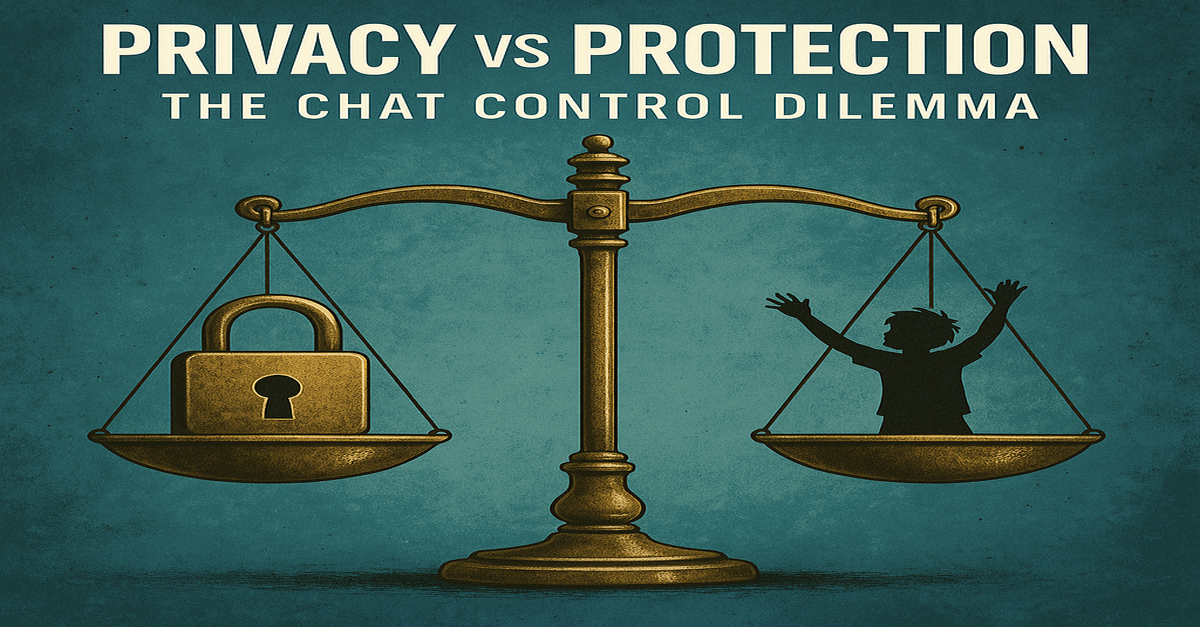Introduction
We all agree: safeguarding children from online abuse is vital. But what if the cure risks eroding the trust and privacy it’s supposed to protect?
The EU’s proposed Chat Control regulation, formally part of the CSAM Regulation, mandates that messaging platforms must scan user communications, even encrypted ones, for child sexual abuse material (CSAM). While its goal is noble, critics warn it threatens privacy, opens the door to surveillance, and may do more harm than good.
Let’s explore both sides…..
What Is the Chat Control Proposal?
At its core, the regulation requires client-side scanning, software built into messaging apps (like WhatsApp, Signal, or Telegram) would automatically check photos, videos, URLs, and possibly text on your device before encryption. If suspicious content is detected, it’s reported to law enforcement without needing a warrant or prior suspicion. The law doesn’t differentiate; all users’ messages would be scanned, not just those under suspicion. This means that The EU could be scanning your chats by October 2025.
The Case for Chat Control: Why Supporters Say it’s Necessary
1. Combatting a Serious Threat: CSAM is horrifyingly easy to share, especially across borders and platforms. Reports show a surge in teen-generated content, and Irish law enforcement struggles to keep pace.
2. Moral Imperative: In The Irish Examiner, Brian Honan hits the emotional core: “We have a moral and ethical obligation to do everything possible to prevent the spread of child sexual abuse material.”
3. EU & Civil Sector Support: EU officials and child protection NGOs broadly back the proposal. It’s seen as a concrete step to stop predators abusing encrypted channels. Some countries, like Ireland, support it; others remain on the fence.
The Case Against Chat Control: What Privacy Advocates Warn
1. Weakening Encryption = Risky Security Gap:
Experts argue that client-side scanning inherently turns every device into a surveillance node. End-to-end encryption (E2EE) guarantees privacy precisely because providers can’t see the content. Any scanning feature introduces a vulnerability, a potential target for hackers or nation-state actors. EU Parliamentary Question and here.
2. High Error, Low Trust:
Detection tools aren’t foolproof. A study, cited by the European Parliament, shows error rates high enough to flag innocuous content. Teen selfies, memes, or personal jokes might trigger false alerts. One Irish insight: only 20.3% of CSAM reports turned out to be legitimate, meaning over 80% were false alarms.
3. Risk of “Function Creep”:
Today it’s CSAM; tomorrow, authorities might scan for political dissent or terrorism. The Guardian warns it lays the foundation for indiscriminate mass surveillance, and Europol officials have even floated widening the scope to other crimes.
4. Technical Surveillance vs. Smart Enforcement:
Academia (including cryptographers like Bruce Schneier) cautions that reconciling CSS with strong privacy is a myth. They dub it “mass surveillance in our pockets,” offering little value in catching perpetrators.
5. Irish Institutional Resistance:
In Ireland, the Oireachtas Justice Committee and ICCL accept the harm CSAM poses, but label mass scanning of 500M EU citizens disproportionate. Liberty must not be sacrificed to convenience.
A Danish Deadline and Growing Momentum
The latest text, introduced by Denmark under its EU Presidency, hopes to finalise positions by Sept 12, with a potential vote by mid-October 2025. While several states now support the regulation, opposition remains strong among privacy advocates, tech experts, and even some member states.
Balancing Act: Real Solutions Without Surveillance
A few thoughts on how we might thread the needle:
- Targeted enforcement, not blanket scanning: Law enforcement should continue court-authorised access, not an all-encompassing search.
- Focus on education, prevention, and platform moderation, not device-level surveillance.
- Robust oversight and transparency: Any regulation must include audits and legal safeguards, ensuring surveillance doesn’t expand unchecked.
- Independent research and pilot programs to measure accuracy and side-effects before scaling.
Final Word
Fighting CSAM is essential, no one can reasonably oppose protecting children. But laws that enable widespread surveillance must come with the strongest checks and open eyes. We must ask: Who watches the watcher?
Empower law enforcement to act effectively, but not without oversight. Reduce abuse, not civil liberties. Because in the quest for safety, democracy must not be collateral damage.
#ChatControl #DigitalPrivacy #DataProtection #OnlineSafety #EURegulation #CSAMPrevention #DigitalRights #EncryptionDebate #SurveillanceState #IrishDigital
